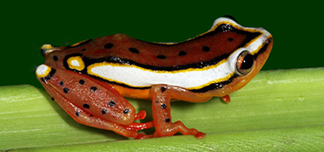Arthroleptis wahlbergii Smith, 1849
Although A. wahlbergi is not classified as threatened, in places its habitat is under pressure from housing development and the clearing of bush for agriculture. More detailed distribution information is needed to evaluate the species’ local conservation status (Text from Minter et al., 2004, © SI/MAB Biodiversity Program).
Food items include woodlice and other crustaceans, beetles and, probably, other small insects that live in the leaf litter (Wager 1986). Predators of A. wahlbergi have not been recorded (Text from Minter et al., 2004, © SI/MAB Biodiversity Program).
A. wahlbergi is endemic to the east coast of South Africa, from just south of Port St Johns northward to the Mozambique border. In Kwa- Zulu-Natal, its range extends inland to altitudes of c.1000 m in the mist belt, where it is particularly common (Text from Minter et al., 2004, © SI/MAB Biodiversity Program).
Breeding takes place during spring and summer, with calling commencing immediately after rain (Channing 2001). In wet weather, males may be heard calling throughout the day and night from concealed positions in leaf litter. Clutches of 11–30 eggs are laid in damp leaf litter and develop directly into froglets which hatch and leave the nest after approximately four weeks (Wager 1986; text from Minter et al., 2004, © SI/MAB Biodiversity Program).
